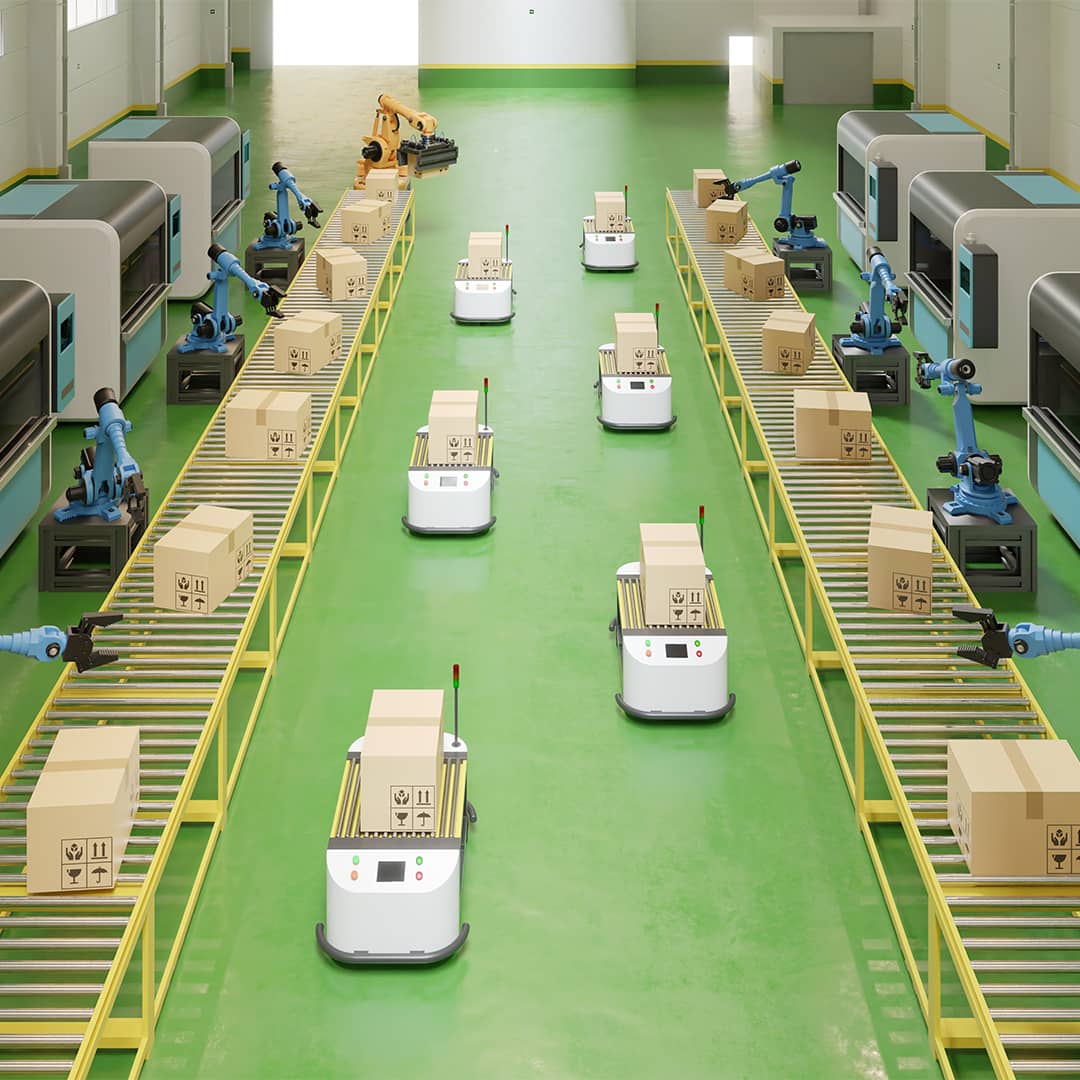Products & Systems
Products & Systems
AGV & Robotics for Industrial Automation
AGVs are driverless robots originally designed for material handling, but advancements in both hardware and software have expanded their capabilities far beyond this initial function. Today, AGVs are not only streamlining material transport but also assisting with tasks in diverse environments such as hospitals, airports, outdoor events, and even homes. Equipped with specialized components like cameras, sensors, and floor markings, AGVs can navigate with precision and efficiently perform a wide range of tasks, making them a versatile solution in various industries.

What is an AGV System, and how does it work??
1. AGV Robot
An AGV is a versatile vehicle that can be customized in shape and size, equipped with advanced software, controllers, sensors, and other components to suit a wide range of applications.
2. AGV Management System
It is a centralized management system that oversees and coordinates the workflow and traffic of the entire AGV fleet.
3. Peripherals
A centralized management system that efficiently monitors and orchestrates the workflow and traffic of the entire AGV fleet.
How do AGV robots work and their types?
An AGV consists of five key components, each assembled and configured according to specific use cases. These parts work together, exchanging information to ensure safe and seamless AGV operations.
Navigation System
to gather directional information using advanced navigation systems, including lasers, magnets, and specialized sensors
Safety System
to navigate and maneuver safely using laser scanners, infrared cameras, and other technologies, ensuring smooth operations without disrupting the fleet
Power System
a battery system that powers movement and supports auxiliary functions
Motion System
to enable movement through motorized wheels, driving systems, and other mechanical components
Controller
It is a logic controller that collects, processes, and coordinates information to manage and optimize all functions
AGV functionalities are evolving rapidly, leading to widespread use across various industries. While many AGV applications are well-established, these vehicles can also be customized to address specific industrial and everyday challenges. Here are some of the most popular types of AGVs:
Automated Guided Carts (AGC)
AGCs, also known as Under Ride vehicles, are compact mobile robots designed to operate beneath trolleys or carts. Commonly used in e-commerce applications, they are among the most cost-effective types of AGVs.
Automated Tow Tractors
The tugger vehicle is designed to tow multiple carts simultaneously. Known for its high capacity and heavy lifting capabilities, it can transport several tons of materials. Tugger vehicles are primarily utilized in automotive industries and assembly lines.
Automated Pallet Jack
These fork-over AGVs are designed for automatic floor-to-floor movement of goods. They efficiently handle tasks such as transporting palletized loads to production lines or delivering finished goods to the warehouse.
Automated Forklif
These highly versatile AGVs can lift and move a wide range of loads within a facility. They are adept at handling diverse racking requirements with both efficiency and safety.
Very Narrow Aisle (VNA) AGV
VNAs (Very Narrow Aisle trucks) are ideal for transporting materials in extremely narrow aisles and for high-lifting applications. They are commonly used in high-density warehouses where space optimization is crucial.
Unit Load AGV
These AGVs are equipped with conveyor rollers to transport multiple unit loads to and from stands, conveyors, palletizers, and other equipment. They are predominantly utilized in the food and beverage industry for their efficiency in handling various materials.
Outdoor AGV
As the name implies, these AGVs are designed for supporting tasks outside a facility, such as vehicle inspections, weather monitoring, and traffic management.
Autonomous Mobile Robots (AMR)
AMRs are employed for specialized applications including last-mile delivery, loading and unloading, stacking, piece picking, as well as cleaning and disinfecting tasks.
Autonomous Security Robots (ASR)
ASRs can be configured for various tasks such as verification, secure check-ins, and area monitoring, both inside and outside facilities. They are commonly utilized at airports, bus stations, and large events for their efficiency and versatility.
Hospitality Robots
These robots are primarily deployed in hospitals and hotels to assist with tasks such as room service, food and medicine delivery, housekeeping, and other general services
What is an AGV Management System, and how it works?
An AGV Management System, whether installed on-premises or in the cloud, integrates with existing ERP, WMS, or other business software to manage data flow seamlessly. Its primary functions include:
1. AGV Fleet Control: Overseeing and coordinating all AGVs.
2. Routes and Traffic Administration: Managing and optimizing AGV routes and traffic flow.
3. Transportation Schedule & Task Management: Scheduling and assigning tasks to AGVs.
4. Real-Time Tracking & Monitoring: Providing up-to-the-minute tracking and status updates.
5. Communication with Business Software: Ensuring smooth data exchange with integrated systems.
The AGV Management System ensures that all robots operate efficiently and accurately. Advanced systems can dynamically adjust AGV routes based on factors like traffic conditions, task priority, and job status, further enhancing operational flexibility.
What are AGV Peripherals, and what do they do?
AGV peripherals are devices that facilitate communication between AGVs and operators, allowing for tasks such as summoning, discharging, or assigning specific functions to the AGVs. For instance, in a hospitality setting, a “Call Room Service” button can be used to request an AGV for assistance.
Examples of AGV peripherals include:
1. Screens: Display real-time information and status updates.
2. Monitors: Provide detailed operational insights and alerts.
3. Buttons: Enable manual control and task initiation.
4. PLCs (Programmable Logic Controllers): Facilitate complex control and automation functions.
These peripherals enhance the interaction and efficiency of AGV operations, ensuring seamless and effective management.
Doing mundane tasks is no longer a burden, lifting heavy loads is a thing of the past, and sending humans to unsafe conditions is no longer required.
This is just the beginning of a new era of industrialautomation to provide a safer and productive working environment for everyone. Adopt AGVs for smarter working.

